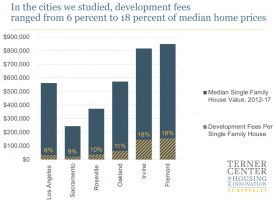https://ternercenter.berkeley.edu/research-and-policy/the-cost-of-building-housing-series/
There are multiple dimensions to the costs of development, many of which have been rising in recent years:
Land Values: From 2000 to 2016, land pricing in the United States climbed by 76 percent—almost twice the rate of inflation. Increases were even steeper in coastal California metro areas, with prices more than doubling in San Francisco and almost tripling in Los Angeles over that same period.
Construction Costs: Over the course of 2017 alone, the national single-family and multifamily construction price indexes increased by 5.6 percent and 6.3 percent, respectively, compared to an average annual increase of 2.7 percent between 1990 and 2000. In that year, New York, San Francisco, San Jose/Silicon Valley, and Oakland ranked among the most expensive construction markets.
Materials and Labor: Core elements driving construction costs include the price of materials and the cost of labor, both of which have also risen in recent years. In 2017, construction materials saw a 4.4 percent price increase, due in large part to escalating cement, steel, and lumber costs. At the same time, wages among construction workers increased 2.6 percent. Relatively low unemployment among construction workers (5.3 percent), may have also contributed to a national construction backlog that reached nine months total in 2017, up four percent since 2016. The western region of the United States saw the largest increase in the construction backlog (13 percent) over the past year.
Development Fees: Development fees refer to the wide range of costs that cities have the authority to charge new housing construction projects throughout the planning and building process. Cities often rely on development fees to fund the provision of city services specific to the building of new housing, like the staff time spent on permitting, inspections, and utility connections. A city may also choose to charge “impact” fees to offset the costs of new development borne by the broader community (e.g., the need for infrastructure expansions to support additional traffic or increased use of water and sewer lines) or to pay for other public benefits (e.g., park access or set asides for new affordable housing development).
These fees, especially impact fees, can be substantial, and they are particularly high in California. In 2015, average impact fees in the state were $23,455 for a single-family home and $19,558 for a multifamily unit—almost three times the national average. Because of how significantly they affect the overall cost of a project, these fees are often passed along to buyers in the form of higher home prices, especially in high demand markets, or can increase the amount of subsidy needed to build affordable housing units. Jurisdictions may also extract additional project-specific fees or requirements on top of codified development fees, which can also add significant additional costs.
Permitting and Development Timelines: The permitting and entitlement process, which is particularly complex in California, can extend development timelines, often unpredictably. Delays in processing or approval timelines can greatly increase the cost of development. The role of processing delays in driving up housing costs has garnered attention at the national level. The Obama Administration identified the negative impact of lengthy bureaucratic procedures on housing costs, recommending streamlining processes and allowing by-right development on priority projects to limit costs.
Regulatory Requirements: Local land use regulations—such as environmental regulations or minimum parking requirements—can also drive up the costs of development and lead to higher house prices. Green building standards in Los Angeles, for example, have increased construction costs by 10.8 percent. While many of these regulations promote public benefits—such as decreased energy use or water consumption—they are often layered on top of one another without a detailed analysis of their impact on the affordability of housing.
Affordable Housing Costs: The cost of building a 100-unit affordable project in California increased from $265,000 per unit in 2000 to almost $425,000 in 2016. The same trends that increase costs for market-rate housing (such as land pricing, construction costs, and regulation) impact affordable housing. In addition, affordable projects are often subject to increased local scrutiny, further inflating costs. A 2014 study found that local government design requirements for affordable housing added an average of seven percent in total costs, and that community opposition (measured by holding four or more community meetings) increased expenses by five percent.
It is clear that not just one element of the development process, but each step along the way influences the cost of building housing, especially in high-demand markets with the steepest affordability challenges. Yet it is not always so clear what is driving the growing expenses within each cost component. Nor are the costs and the benefits of layering additional public policy goals onto housing always explicitly weighed or understood. We need better data to understand and effectively respond to the complex dynamics that affect the costs and feasibility of building housing, especially when it comes to using scarce public subsidy to build affordable units.


